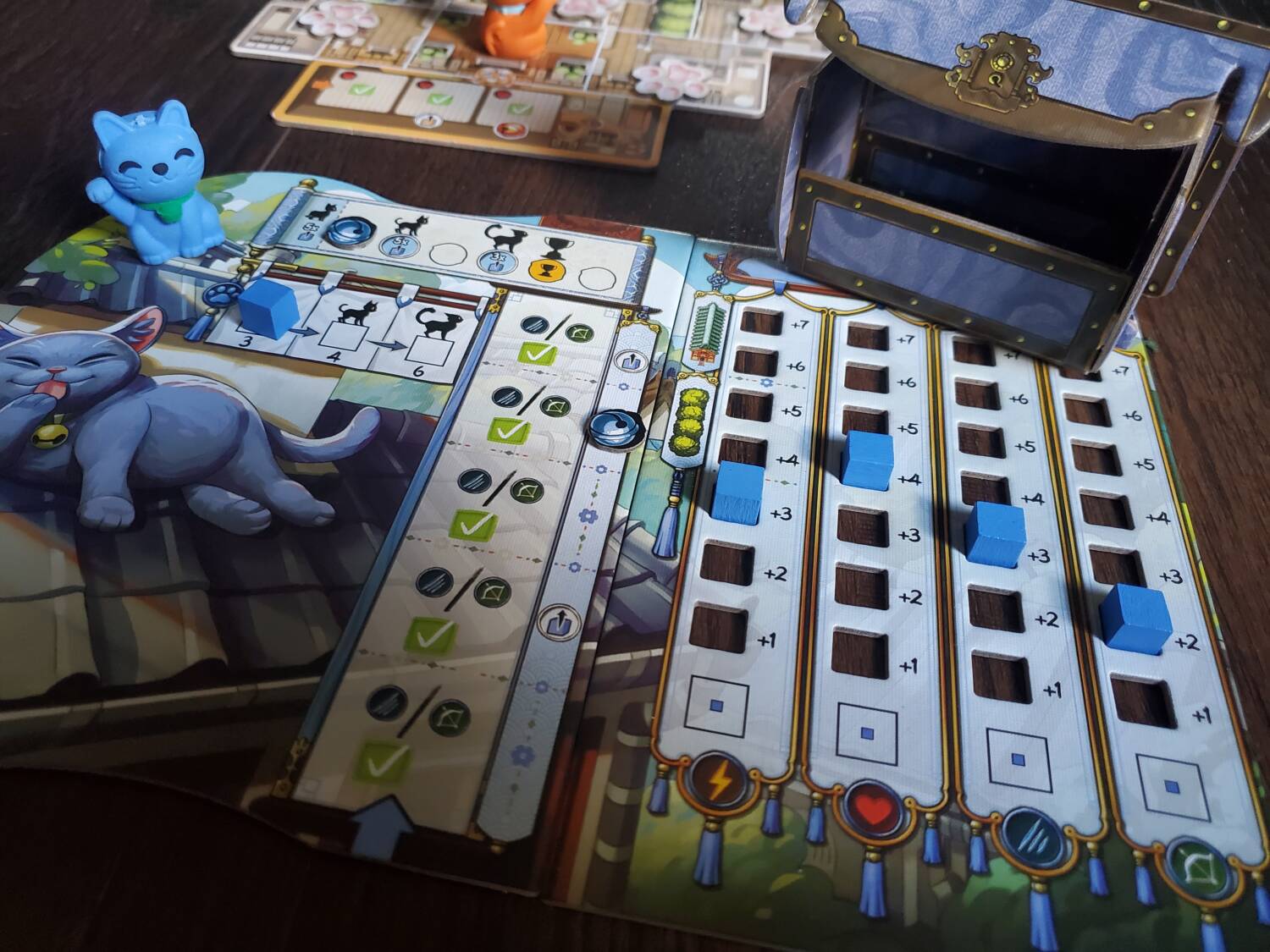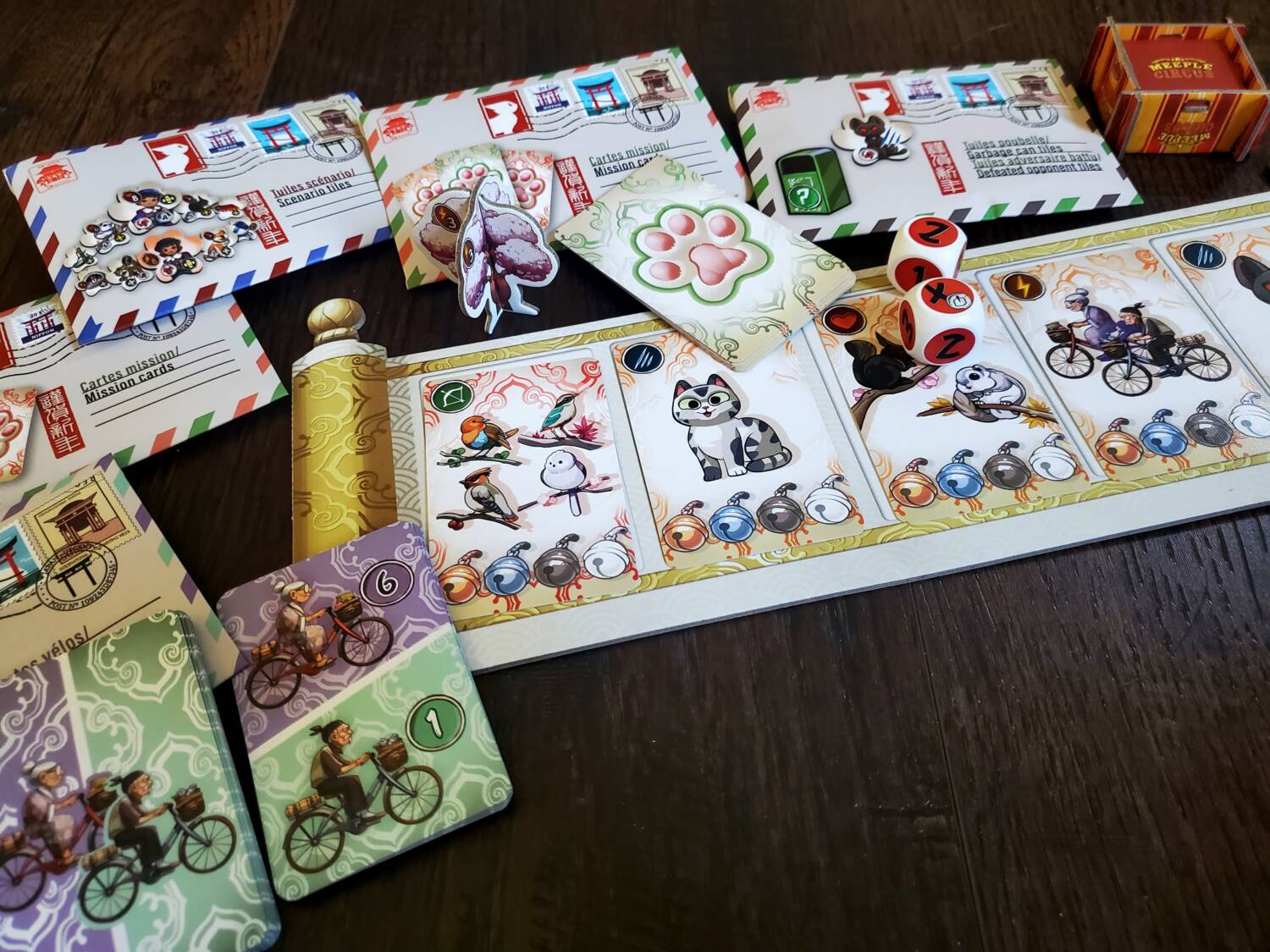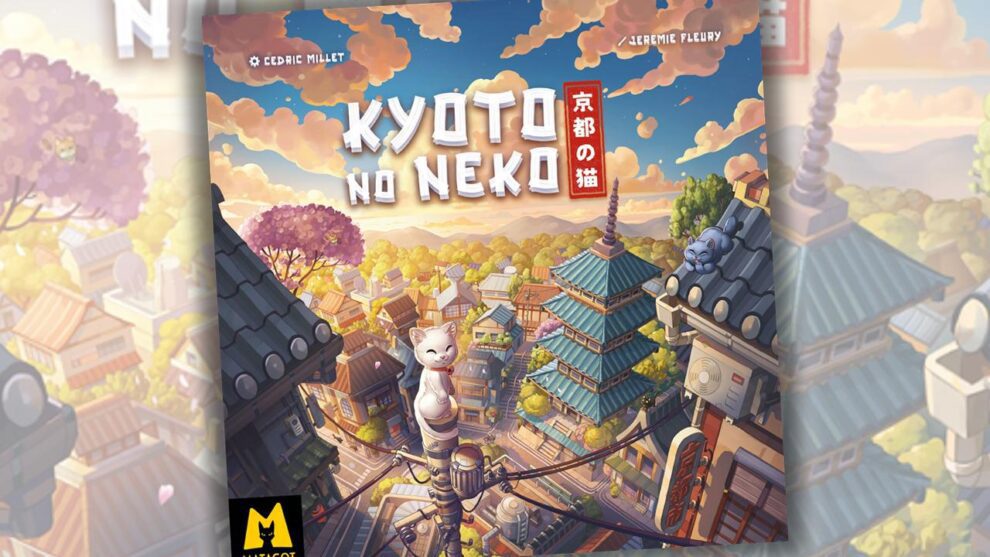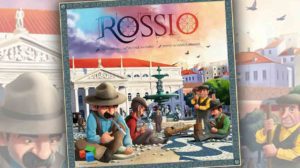Disclosure: Meeple Mountain received a free copy of this product in exchange for an honest, unbiased review. This review is not intended to be an endorsement.
Pencil erasers. You know the sort, the molded 3D variety that were never intended to erase. They were more like elementary school status symbols, beacons of personality that wagged in the air as you filled in bubbles with your Ticonderoga No. 2. Truth be told, they were a bit of a nuisance for how they threw your pencil out of balance, but they looked so cool.
Finally, someone has made a game with erasers as player markers—minus the hole necessary to properly top a pencil. It was the artwork that first drew me in as I listed Kyoto No Neko among my most anticipated list for GenCon 2024. Even as I tore into the shrink to check out the illustrations, though, I had to pause to admire the kitties made of the stuff of erasers. Endearing, they are.
In fact, everything about Kyoto No Neko has a charming look. The square board is flanked on all sides by stair-stepped player-specific territories to create a unique overall shape. The finished grid is an overhead map of the city: rooftops, terraces, and roadways for kitty travel. Cute little kitty paw tokens are scattered about, face-down and waiting to be discovered.
Feline It Out
The whole of the game is a series of skill checks. Every token requires one of several skills: agility, friendliness, toughness, or prowess. Every skill is measured by a cube on a track combined with a roll of a single die. The eraser-kitties move, flip tokens, and engage.

The agility tokens have to do with being the best at kitty parkour. For the most part, agility is the mechanism of defense against hostile tokens. When dangerous things surface, they become a forced skill check—fruitfully run from the angry dog, dodge an oncoming bicycle or be chased back towards home. Trees are hardly hostile, but they are an opportunity for gain. Every failed skill check means sliding the cube up one, with total failures serving up an additional notch.
Rival kitties are hidden all over the place and offer a choice: make a friend or start a cat-fight. Friends come back to your place to chill—failure here leads the target to flee your apparent awkwardness. Defeated foes score notches on some sort of feline war belt, but in failure you run for home with your tail between your legs. When it comes to prowess, there are bugs and mice all over just asking to be hunted. Various other tokens dot the landscape: birds to hunt, butterflies to befriend, etc.

Kyoto No Neko is a race to five specific successes. There are five variable objectives in each game that direct efforts. Climb a tree. Cross the street. Successfully dodge a bike. Bag a mouse. Beat up one of your opponents (obviously a favorite). Two additional objectives are static: Hunt at least four somethings and befriend three somethings. As the city reveals its secrets, it’s all about getting stuff done. That’s what cats do, I guess.
When any player achieves their second objective, and then again when someone reaches four, everyone is blessed with increased movement and a number of ticks on the tracks. In this way, everyone is constantly getting stronger, and the race accelerates to its end.
Feline Groovy
Where Kyoto No Neko comes alive is in the Scenario booklet. I was surprised that the addition of a simple mechanic or two could inject so much life into the experience. The base game can be a bit of a snooze-fest, bland and instructive, waiting for a shot of adrenaline. There are eight opportunities, however, for the game’s personality to shine, not to mention the possibility of then mixing and matching components to create your own.

Shiba, one of the Scenario objectives, is a cute little puppy that you really want to have as a friend. What makes Shiba fun is that pushy kitties are more than welcome to meander over to opposing kitties’ flats to steal friends. Where the hesitant player might ignore this opportunity in the base game, Shiba fires up the competitive streak by making it nearer to a requirement. In the same way, the “win a cat-fight against an opponent” objective says, “I don’t care if you prefer to play nice. You’d better beef up your toughness ‘cuz I’m about to pick on someone my own size.”
Mailboxes show up with all sorts of things inside to discover. Friendly humans walk about who would just love to be discovered. Mean girls, too. Sometimes kitties need to mark their territory before an opponent covers the scent. And sometimes you just need to curl up inside the top of a board game box. These extras, small as they may be, are the real flavor. And the more directly they prompt interaction, the better.
You Feline Me?
I must raise issues with the production. First, sadly, are the beloved eraser kitties. Despite my earlier attempts to romanticize their appearance, they are, in a word, ridiculously frustrating in practice. They are—to be more specific—ridiculously frustrating when unleashed on a modular board lacking proper locks, puzzle knobs, or the like to hold the world together. The kitties, they don’t slide. The painful reminder of this is the constant need to realign those side boards as the gritty kitty rubber grips the cardboard and knocks Kyoto about the table. Pick up, set down, people. Pick up, set down.

Each player’s private board is also divided, with one piece depicting the kitty and the other the skill tracks. I really don’t know why this was the choice when they could easily have been printed on a single, two-sided punch board. They, too, suffer from detachment issues. The back is printed with a configuration for new players that could easily have been described in a word in the rulebook, but I’m not even sure that was the reason?
Matagot went with envelopes for the various Scenario tokens and bits. They are serviceable, but take a bit of fiddling. I prefer paper bags as a baggy alternative since kitties aren’t known for their mastery of the postal service.
My final gripe is with the standees. They are, in a word, a functional fail. The bases don’t hold, which means the pieces don’t stand. Some, like the cyclists, have no choice but to lay down on the board because they fall apart at the slightest touch. Others, like the boy and the girl, really can’t lay down so they force the awkwardness of picking them up gingerly by the base. I really, really felt let down by these because the game’s third dimension—random standing reveals—is part of its quirky appeal.
Those features aside, I love the boxes that hold the player components and the paw tokens. I bristle at the notion of constructing cardboard boxes for such things, but these are well designed and rather satisfying to use. It feels good to simply hand each player their things in so stylish a fashion—reminiscent, in a cartoon kitty way, of Obsession’s appropriately classy family boxes.
Overall, Kyoto No Neko is charming on the table, but it is charm with a hint of disappointment.
Feline the feels
Our first play was the base experience with two players. I almost didn’t want to come back. Our second play was also with two players, but with Shiba. This second play proved the concept. Kyoto No Neko is fun inasmuch as it draws everyone to the center. The center board’s sixteen grid squares are where the Scenario bits land in every play. They create competition, draw personalities out into the light, and invite a manageable level of chaos.
On that note, more players equal more fun. With two it’s a straight efficiency battle—beef up the skills and reap the benefits. With three, there is a risk of two players locking up in a battle while the third sneaks in for a win, an interesting narrative but also an exploitative strategy. Four players introduces a hint of downtime, but it feels like all the little movements matter when there’s less room to breathe.
My daughter has requested this game every day since she met Shiba. Even at six she’s perfectly capable of living within the ruleset, but her tendency toward singular focus on the cute puppy means I often win. She doesn’t care. Playing with more, with varied ages, has been a relative win, though. I can see families getting some mileage out of this one through the various Scenarios and component possibilities.
I’m really hung up on the component gaffes. If the pieces matched the charm of the gameplay, or even simply avoided aggravating my neat-freak, everything-must-line-up tendencies, I might have another star to lend. But as it is, I spend too much time tidying up. Kyoto No Neko is a pretty good game that just misses out on providing a great presence to match. But I’m sure I’ll be chasing Shiba as long as my daughter wants to be at the table.











